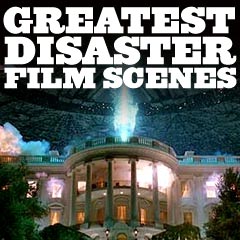
|
Film Scenes 2010s |
| Film Title/Year and Description of Disaster Film Scene | ||

|
Contagion (2011) Director Steven Soderbergh's taut sci-fi drama-thriller about lethal virus contagion was not to be confused with the earlier film Contagion (2002) by director John Murlowski, starring Bruce Boxleitner as the infected US President. It followed the similarly-themed Wolfgang Petersen film Outbreak (1995), starring Dustin Hoffman. The taglines were:
In a story interwoven by numerous subplots and performed by an ensemble cast, the catastrophic medical pandemic began with the spread of an infectious, pathogenic virus. A cough was heard under a black screen. The disease was first acquired by Elizabeth "Beth" Emhoff (Gwyneth Paltrow) after a business trip to Hong Kong. Soon after, she died in her Minneapolis home along with her 6 year-old son Clark. For some reason, her husband Mitch (Matt Damon) did not contract the disease. The contagion rapidly spread, with symptoms including coughing, high fever, brain hemorrhaging, and death. [Later, Beth was declared 'patient zero.'] Director Soderbergh effectively presented how germs can easily be transmitted from one person to the next by one touch, by a cough, a handshake, a doorknob, a credit card, etc. In the CDC in Atlanta, Dr. Ellis Cheever (Laurence Fishburne), who wrongly theorized that the disease was a bio-terrorist act, sent researcher Dr. Erin Mears (Kate Winslet) to Minneapolis to investigate the growing epidemic that was caused by a fatal airborne virus. She was soon infected and also died. Ultimately the death toll was 26 million worldwide. The contagious virus was found to have been derived from pig and bat viruses, and was named Meningoencephalitis Virus One (MEV-1). There was a subplot about a paranoid conspiracy theorist and blogger-activist named Alan Krumwiede (Jude Law) faking the illness, and promoting forsythia as a homeopathic cure, in order to create profits for the distributor. When a real vaccination cure was finally developed, there was further intrigue over who should receive the inoculation. Another subplot was about the kidnapping of WHO Dr. Leonora Orantes (Marion Cotillard), an epidemiologist who went to China and was held until it was arranged for her to be released in exchange for doses of the vaccine. |
       
|

|
Gravity (2013, UK/US) Director and co-writer Alfonso Cuarón's and Warner Bros.' stunning drama and outer-space survival tale won an astounding seven Academy Awards, including Best Director, Best Cinematography, Best Visual Effects, Best Film Editing, Best Sound Mixing and Sound Editing, and Best Original Score (Steven Price) - but it lost Best Picture to 12 Years a Slave (2013). The sci-fi tale told about two astronauts aboard their NASA space shuttle Explorer in the vastness and beauty of space:
During a space walk repairing the Hubble Space Telescope, stray space debris struck the telescope and the Explorer, killing the entire crew. The debris consisted of the remains of a defunct Russian satellite that had deliberately been destroyed by a Russian missile. The two astronauts became stranded in a Manned Maneuvering Unit (MMU) - and decided to seek refuge in the International Space Station (ISS) a long distance away. It became a race against time since the space debris would return in about 90 minutes. During maneuverings at the ISS and at one of its two Soyuz space capsules, Kowalski became entangled in a tether line and had to let go to save both of them (he commanded her: "Ryan, listen...You have to let me go...the ropes are too weak. I'm pulling you with me. You have to let me go or we both die") - he unhooked himself and floated away to certain death in space. For the remainder of the film, the resilient and resourceful Stone (who at one time contemplated suicide) was able to survive against overwhelming odds. At first when the ISS caught fire, she was able to escape and enter the Soyuz capsule. She propelled it toward another nearby Chinese space station (Tiangong) and one of its capsules-pods (Shenzhou), so that she had a means to reenter Earth's atmosphere. During the difficult re-entry ("one hell of a ride"), the capsule tumbled and dangerously overheated, caught fire due to a malfunctioning heat shield, and the pod landed in a lake. She was forced to evacuate the pod almost immediately, stripped off her spacesuit to avoid drowning, swam to the surface, and miraculously reached the shore (symbolic of her rebirth). |
     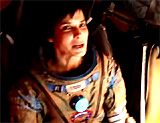 
|
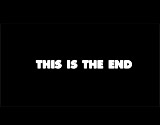
|
This is the End (2013) Co-directors Seth Rogen and Evan Goldberg helmed this very funny although very R-rated disaster film - a crude and gross-out fantasy comedy - about what might happen as the result of a global apocalyptic event (pre-ordained by religion or the Bible). It was based upon the short film, Jay and Seth vs. The Apocalypse (2007), co-written by Evan Goldberg and Jason Stone, and directed by Stone (and starring Seth Rogen and Jay Baruchel). The full-length feature's tagline was:
Other films in the same time period were the black comedy It's a Disaster (2012), the post-apocalyptic drama Goodbye World (2013), and the fantasy-comedy Rapture-Palooza (2013). Many of the cast members were actors playing pretentious versions of themselves (and making fun of their own public personas), in this end-of-days satirical film that paid homage to many big-budget apocalyptic disaster-thriller films. In the ensemble comedy, a large gathering of individuals was at a housewarming party in James Franco's fancy new Hollywood home. He was joined by pot-smoking and fast-food devouring pals Jay Baruchel and Seth Rogen, cocaine-snorting Michael Cera, and lots of others. While Jay and Seth were briefly out at a convenience store purchasing cigarettes, the "end" came. The earth cracked open and sucked unfortunate souls downward in a fiery hole that formed in the yard, and blinding blue lights shone down from Heaven during the Rapture - to take the do-gooding 'saved' into the skies. At the boarded up house, a small group of select survivors hunkered down to protect themselves from the demonic forces of Hell and those who became devil-possessed. Michael Cera was skewered by a lamp pole, a decapitated head was kicked around like a soccer ball, and Jonah Hill needed to be exorcised. The finale was a special-effects bonanza (featuring a flaming, giant horned Demon Beast walking through the ruins of Los Angeles), in which some of the partygoers were enraptured to Heaven within a bright blue beam after performing a selfless or sacrificial act. Stupid wishes of the heaven-sent (wearing white and halos) in a dazzlingly-bright paradise came true -- a resurrected performance by the reunited Backstreet Boys! |
       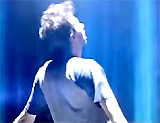 
|
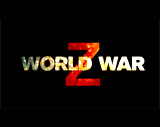
| World War Z (2013) Director Marc Forster's highly-successful apocalyptic action-thriller and zombie creature-film was based upon Max Brooks' 2006 pseudo-historical novel about a series of zombie plagues: "World War Z: An Oral History of the Zombie War." This horror film told about a race-against-time around the globe to investigate the spread of zombies, known as World War Z (for Zombie), to discover their source, and to halt their proliferation. It was set in a time of many global zombie uprisings and outbreaks over a period of years, caused by a highly-contagious, infectious disease-virus. Locales included Philadelphia, Pennsylvania, then Newark, NJ., South Korea, Jerusalem (Israel), and Cardiff (Wales). The story opened in a Philadelphia traffic jam, experienced by ex-UN investigator Gerry Lane (Brad Pitt) - with his wife Karin (Mireille Enos) and their two daughters seeking refuge in Newark, NJ. Suddenly, chaos, explosions, and an attack of zombies signaled a growing zombie pandemic-plague in the area. Bitten individuals were suddenly reanimated in just a few seconds to join the hordes of fast-moving, infected, rampaging undead maniacs. Lane was sent on a worldwide mission, in a race against time, to discover the source of the rapidly-spreading, threatening disease. While his family were evacuated and protected on a UN-sponsored US Navy fleet/carrier stationed offshore in the Atlantic Ocean, Lane studied the problem to try to determine the root cause or origin - and realized he must locate patient zero. His travels took him to South Korea, and then to Jerusalem (where a safe zone wall protected the uninfected). The most spectacular scene in the film was when the zombies intelligently scaled the wall and overtook the city. He witnessed that zombies avoided attacking the sick, injured, terminally-ill, and elderly people (unsuitable hosts for viral reproduction). His next stop was a World Health Organization (WHO) outpost in Cardiff - during the plane ride, zombies infected almost all the passengers and Lane was forced to use a hand-grenade to rupture the cabin and deliberately crash the plane. Although impaled by shrapnel, Lane was one of two survivors, but blacked out and went into a coma. When revived days later, he learned that his family had been brought to the mainland, to a safe zone in Nova Scotia, and reunited with them. As an antidote to the virus, he suggested inoculating the uninfected with pathogens that would be curable, to disguise them from the ravaging zombies. In the WHO lab, swarming with zombies, Lane took a desperate chance and injected himself with one of the vials of unidentified pathogens. He first tested the inoculation's protection with a face-to-face encounter with a single zombie - it ignored him ("It just walked right past him"), proving that his theory was a success. He collected more samples of the effective pathogen, and retreated through hordes of other zombies in the hallway that also ignored him. Lane was soon cured of the disease, hopefully saving the world from annihilation with the masking 'vaccine' agent that was delivered to troops battling the zombies. Lane delivered the film's last line: "If you can fight, fight. Be prepared for anything. Our war has just begun." Zombie hordes were still attacking Paris and Moscow. |
    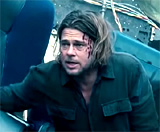   
|

|
Godzilla (2014) Director Gareth Edwards' blockbuster sci-fi film was the latest in a steady stream of remakes (or reboots) of the original Japanese film about a giant reptilian king of monsters. It was released on the 60th anniversary of the original film (and co-produced by Warner Bros. and Legendary Pictures), and marked the second Hollywood Godzilla production:
All of the films took their inspiration from Eugene Lourie's earlier The Beast from 20,000 Fathoms (1953). This film's tagline was: "The King Will Rise." The first characters to be introduced were: Joe Brody (Bryan Cranston), the lead nuclear power-plant manager at the Janjira plant in Japan, and his wife Sandra (Juliette Binoche), also an employee (regulations consultant). On the occasion of Joe's birthday in 1999, seismic tremblings were actually signs of an impending nuclear meltdown. The causes of the deadly incident (the collapse of the plant) that led to Sandra's death (from radioactive mist) were covered up (and regarded only as quake-related) for a decade and a half. A new Brody family - the next generation - was then introduced:
Ford traveled to Japan when he heard of his father Joe's arrest for trespassing. Upon bailing out his dad, Ford learned that his father had become a rabid conspiracy theorist who suspected foul play at the Japanese power plant 15 years earlier. The two traveled to Joe's old home (surprisingly radioactive free) and the "quarantined zone" of the plant - to investigate the cause of the 1999 meltdown. Security guards apprehended them, and brought them to meet with scientists in charge of Project Monarch: Dr. Ishiro Serizawa (Ken Watanabe) and British assistant Dr. Vivienne Graham (Sally Hawkins). They were studying a large, cone-shaped, cocoon-like organic structure - a chrysalis that soon unleashed an irradiated, giant airborne winged-creature (dubbed MUTO - Massive Unidentified Terrestrial Organism) that demolished the facility (and lethally wounded Joe). Evidently, it was found that there were two destructive, hatched MUTOs in existence: a male in the Pacific Ocean area bound for Hawaii, and a female in the Las Vegas area, that both sought nuclear radiation (for consumption) and were using echolocation to find each other, in order to reproduce. It was also learned that the nuclear-atom bomb tests in the 1950s were actually failed efforts to kill Gojira (or Godzilla), but the radiation from the explosions became a food source for the creature at "the top of the primordial ecosystem. A god, for all intents and purposes." Soon, this ancient beast-predator was summoned from dormancy in the Philippines - the Godzilla leviathan ("an ancient alpha predator"). To restore balance in nature, Godzilla was tracking the male MUTO. The two confronted each other for the first time in Honolulu. After massive damage to the city, the MUTO managed to escape and proceeded further eastward in flight, with Godzilla in pursuit. Godzilla arrived in SF Bay, where it was warily watched by the military. The monster squared off and battled the two MUTOs that had already met and reproduced, creating a nest of eggs. The eggs were destroyed with flaming gasoline, and Godzilla emerged victorious against the two creatures, although weakened, injured, and collapsed. After reviving, the kaiju stomped toward the water and swam away following a victory roar. TV headlines on a Jumbotron in the SF stadium shelter proclaimed: "KING OF THE MONSTERS - SAVIOR OF OUR CITY?" |
     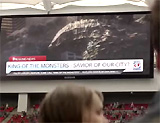   
|

|
Noah (2014) Director Darren Aronofsky's big-budget, critically-bashed adventure drama told the age-old epic Biblical tale of Noah, his Ark and the Great Flood. The reinterpreted story had been told previously in various filmic versions:
The newest adaptation of the timeless Genesis tale, with sci-fi elements, told about a man of God named Noah (Russell Crowe). In one section of the film, Aronofsky beautifully visualized the Creation story, the Evolution of Life, and the Garden of Eden. Noah received a vision to construct an Ark to start again in a new and better world. It would hold pairs of innocent, saved animals from Earth ("A great flood is coming. The waters of the heavens will meet the waters of earth. We build a vessel to survive the storm. We build an ark"). A giant apocalyptic flood would cover everything and destroy mankind's sins and evils, personified in the defiant, confrontational character of Noah's nemesis Tubal-cain (Ray Winstone). The tormented Noah was advised by his hermit-like grandfather Methuselah (Anthony Hopkins) and assisted in the building by fallen angels known as Watchers (voiced by Sanyaza (Nick Nolte)), encrusted as gigantic stone golems (nephilim) (digitally-created and similar to Rock Monsters or Transformers). Other members of Noah's family (involved in many sub-plots about barrenness and fertility) included:
After a period of about eight years, the Ark was completed, and animals streamed into the massive structure, where they were anesthetized by incense. Geysers of water and a massive hurricane formed to produce flood waters that inundated the Earth. Unlike most blockbuster disaster films, the sequence of the devastating flood was fairly brief. In the film's last lines after flood waters had receded, Noah blessed his grandchildren and descendants for the hopeful future (symbolized by a rainbow):
|
   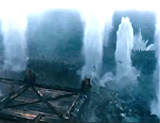   
|

|
San Andreas (2015) Director Brad Peyton's stereotypical disaster film was about a state-wide California earthquake on the San Andreas faultline that destroyed both Los Angeles and the San Francisco Bay Area. The main characters of one family were the human backdrop to the catastrophes. They were experiencing marital difficulties in the midst of the disaster:
An impending disaster was signaled when a fault line ruptured and caused a 7.1 earthquake near Hoover Dam. It collapsed the structure, and caused the death of CalTech seismologist Dr. Kim Park (Will Yun Lee) (among others), while his colleague Dr. Lawrence Hayes (Paul Giamatti) was lucky to survive. The San Andreas Fault was triggered, and a 9.1 earthquake destroyed downtown Los Angeles. In a daring rescue effort via helicopter, Ray saved ex-wife Emma from death in a crumbling building. Ray was then called upon to make the difficult trek with Emma to San Francisco, an area also experiencing a series of earthquakes ("It looks like the whole San Andreas fault line is being activated - and it's heading toward San Francisco"). Everything was capped by a 9.6 magnitude shaker. His mission was to save his daughter Blake (and others with her, including Daniel, Ben, and Ben's younger brother Ollie (Art Parkinson)). Ray's only means to get into the city was to sky-dive with Emma onto the playing field of AT&T Park/stadium. Views were of downtown buildings, the Oakland Bay Bridge, and the stadium - all crumbling. The main disaster sequence was the sight of a mega-tsunami approaching the Golden Gate Bridge. A giant cargo-freighter was caught in one of the massive waves, struck the center of the bridge, and snapped the span in two, sending cars into the water (and killing Daniel - crunched by a container). The waves continued onto the city, to quickly swamp vast areas of San Francisco's downtown, where Ray miraculously saved Blake (who had apparently drowned but was revived). The final cliched words of the film were about Emma and Ray rebuilding their lives, while huddling together:
The last view was of a separated San Francisco peninsula (now an island) from the rest of the South Bay. |
        
|

|
Deepwater Horizon (2016) This visually-powerful biopic disaster film from director Peter Berg was based on the real-life incident that occurred in the Gulf of Mexico in the spring of 2010, involving the explosion of the Deepwater Horizon offshore drilling rig (with 28 on board) and the subsequent devastating oil spill (the largest in history). There were 11 deaths and many injured. The fires on the rig lasted for two days until the flames consumed the platform and it sank to the bottom of the Gulf (5,000 feet down). Leaking oil in to the Gulf lasted for almost 3 months (87 days). The setting was offshore (about 50 miles) near southern Louisiana where a BP oil rig (actually a gigantic floating ship) was drilling deep into the ocean floor. The story of how the oil rig had a weakened concrete foundation that hadn't been tested (causing structural problems that led to the catastrophe), was told in human-personal terms and with life-saving heroics, with the following characters:
A late pressure test (with the dial moving negatively into the red zone) weakened the already failing foundation and led to the "blow-out" explosion and fire that ignited the oil and gas and killed 11 workers (out of about 120 crew). Having missed getting on the sole lifeboat that was launched, Williams, the last one on the rig, was forced to jump off at a distance of about 10 stories above the water. |
     
|

|
Independence Day: Resurgence (2016) Director/writer Roland Emmerich's summertime blockbuster was an over-done remake. The sci-fi adventure-action film was Emmerich's first sequel, coming 20 years after his own original hit: Independence Day (1996) - about alien invasion. The tagline reiterated:
As a prelude to the unsatisfying, mediocre film (with a huge ensemble cast and lots of sub-plots about a group of young fighter pilots), it was described how in the previous 20 years, a sophisticated Earth Space Defense (ESD) program had been established, with Area 51 in Nevada as its headquarters (led by neurotic director David Levinson (Jeff Goldblum)), and both Moon and Mars had been colonized. But there were disturbing signs that elderly ex-President Thomas Whitmore (Bill Pullman), African nation warlord leader Dikembe Umbutu (Deobia Oparei), and later coma-awakened mad scientist Dr. Brackish Okun (Brent Spiner) were suffering from post-alien attack symptoms - they were scribbling strange alien symbols, and receiving images of a large spherical object. An alien spacecraft (later discovered to be benevolent) appeared on the Moon and was promptly shot down. Shortly thereafter, a more menacing immense mothership (with a diameter of 3,000 miles) attacked the Moon base, then set its sights on Earth. With its strong gravitational pull while passing over, it levitated parts of Asia and the Middle East (China and Dubai), and the debris (skyscrapers and other objects) fell over parts of Europe (London and other cities) ("What goes up must come down"). Cities on the Eastern US coast were also damaged. Next, the alien Mothership (with a group of "Harvesters" led by an alien Queen) began to drill through the ocean to the Earth's core to harvest it and provide fuel. Military jets dispatched to attack the mothership were mostly neutralized by its EMP (electro-magnetic pulse). Whitmore, an ex-Persian Gulf War combat pilot veteran, volunteered to fly an heroic suicide mission against the Mothership at Area 51, causing it to be destroyed by nuclear weapons. A few attempts finally led to the death of the Queen, and to the retreat of the alien fighters and Mothership. The postscript to the film was that the US partnered with the benevolent aliens (who were communicating through a large white sphere), who had earlier resisted the evil Queen's "Harvesters," and whose survivors were still hiding on a refugee planet. They offered to provide the humans with new technology and weapons that could successfully counter-attack against the Harvesters' home world. The film's last line was delivered by Dr. Brackish Okun: "Time to kick some serious alien ass." |
    
|